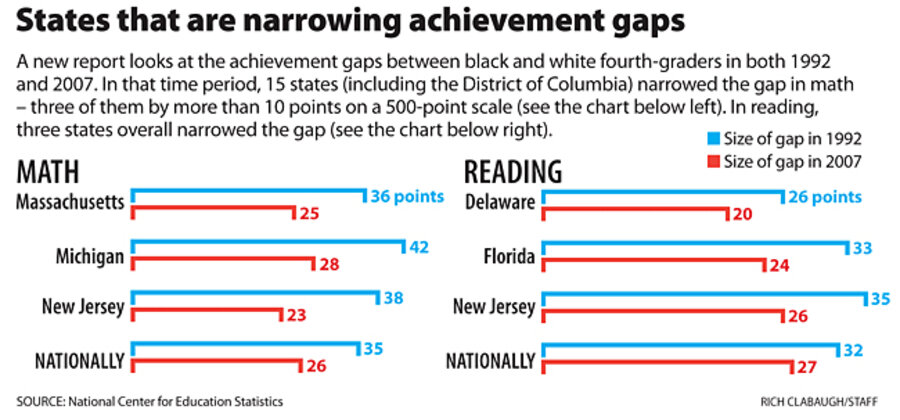Blacks' test scores lag, but New Jersey is a bright spot
Loading...
Look behind the curtain of national averages, and you'll gain new insights into the gaps between whites and blacks in test scores:
While reading and math scores for students of both races have generally risen since the early 1990s, black students continue to lag behind in every state. And while the gaps haven't grown larger, only a fraction of states have succeeded in narrowing them.
"The stark fact is that the gaps in school and life experiences that mirror the gaps in school achievement are still with us like an unwanted guest," said Paul Barton, senior associate at the Educational Testing Service's Policy Information Center, during an event Tuesday in Washington to release the new report.
States and school districts continue to grapple with how to close achievement gaps and the opportunity gaps that contribute to them, which persist despite the fact that American schools have been officially desegregated for more than half a century.
Just last week, school officials in Philadelphia voted to settle a desegregation lawsuit that had been brought in 1970 in an effort to close gaps between white and minority students. The district agreed to channel more resources to low-performing racially isolated schools, where at least 9 out of 10 students are of one race. And in Minneapolis, debates have cropped up over the district's latest effort to change the formula for assigning students to schools to even out racial distribution, resources, and achievement levels.
"Achievement Gaps" is the latest US Department of Education analysis of the National Assessment of Educational Progress (NAEP), which periodically samples student performance in various subjects and grade levels. This report focuses on the achievement of public-school students.
As previous NAEP reports have shown, gaps have been narrowing the most at the fourth-grade level in mathematics. Fifteen states narrowed those differences between 1992 and 2007 (see chart). Four states narrowed the gaps in eighth-grade math.
In reading, only three states narrowed the gaps at fourth grade, and no states saw a significant change at the eighth-grade level.
New Jersey narrowed gaps in both reading and math for fourth grade. One reason behind the state's progress is a funding distribution system that has sent more resources to schools in high-poverty areas to bring them up to the funding level of more-successful schools, says Michael Holzman, a research consultant for the Schott Foundation for Public Education in Cambridge, Mass. Newark, N.J., is one of just four large districts in the United States where African-American males graduate from high school at rates comparable to the national average for white students, he says.
Department of Defense schools have smaller math and reading gaps than the national average, according to the new report. "There are many aspects to the military approach to education and development that are worth emulating," said Hugh Price, a senior fellow at the Brookings Institution, at the Washington event Tuesday. Mr. Price is also a former president of the National Urban League. "These include ... teamwork, motivation, and self-discipline ... accountability and consequences ... mentoring and monitoring, and providing frequent rewards and recognition."
-----
Follow us on Twitter.





